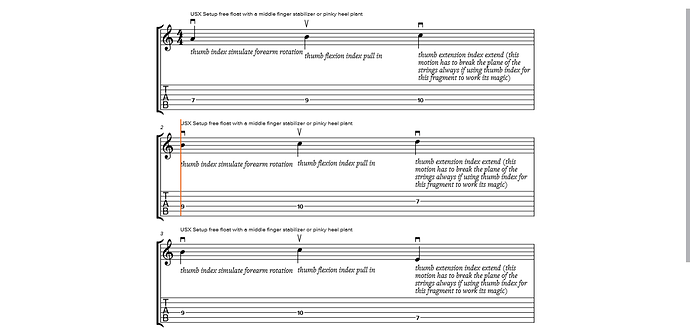i was going through the motions today looking at all the different escape hatches and just that first 3 strokes of the single string pattern
downstroke (thumb index only as place holder for forearm rotation)
upstroke (thumb flexion index in)
downstroke (thumb extension index out)
pick is outside the plane of the strings
probably for myself that is one of the most powerful fragments of my techniques. it helps you escape the string on a downstroke.
now can i incorporate that at high tempo i dont know yet, maybe on certain phrasing I can, maybe not, but the technique appears very bulletproof. however to ingrain it into my playing may never happen, nevertheless the power in that takayoshi technique seems really solid. utilizing this will require extreme consistency, and the only other technique that really opened my eyes to extreme consistency was rest stroke. I don’t know how well I can get with consistency on that specific group of motions inside my playing. the problem with the consistency thing is for rest stroke its simple to keep track of in your brain as you are mainly focusing on one motion, the rest, with this technique you have to keep track of the thumb flexion and extension move when you need it. so it is like keeping track of both the rest stroke, and the thumb flexion and extension moves in real time. without knowing the phrase before hand that move itself to me is a bit useless, however if you bake in a phrase with it you probably could get some things to warp speed with some grinding.
to be more specific you need to know these two moves. the second one has two variations, whether or not it is possible to use these at warp tempo i have no clue, but I take it takayoshi was able to so it probably just takes alot of playing phrases with these incorporated to really get them fast.
and honestly now that i have been more aware of the motion, you have to approach it knowing if you flex the thumb in you have to flex it out if you want to go into some other motion. with my hands in particular when i do more forearm rotation my thumb is more in an extension setup, so if i go into this motion in order to exit i have to be aware that if i am in thumb flexion i have to do a down stroke to get out of it. this means even if you don’t use the down stroke escape hatch, and you desire to maintain the pick trapped on the downstroke that you still must be aware that when you do a up stroke thumb flexion, you will have to do the opposing motion to get set back up if you desire to go into another picking mechanic.





 | Tablature for MEMBERS - YouTube
| Tablature for MEMBERS - YouTube